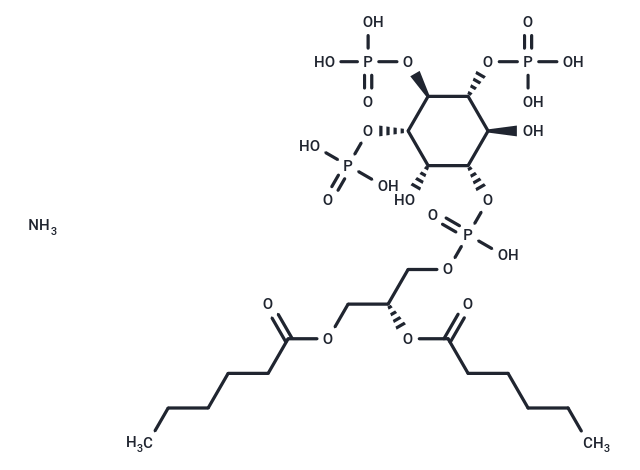- Remove All
 Your shopping cart is currently empty
Your shopping cart is currently empty
PtdIns-(3,4,5)-P3 (1,2-dihexanoyl) (ammonium salt)
The phosphatidylinositol (PtdIns) phosphates represent a small percentage of total membrane phospholipids. However, they play a critical role in the generation and transmission of cellular signals. PtdIns-(3,4,5)-P3, also known as PIP3, is resistant to cleavage by PI-specific phospholipase C (PLC). Thus, it is likely to function in signal transduction as a modulator in its own right, rather than as a source of inositol tetraphosphates. PIP3 can serve as an anchor for the binding of signal transduction proteins bearing pleckstrin homology (PH) domains. Protein binding to PIP3 is important for cytoskeletal rearrangement and membrane trafficking. PtdIns-(3,4,5)-P3 (1,2-dihexanoyl) is a synthetic analog of natural PIP3 with C6:0 fatty acids at the sn-1 and sn-2 positions. The compound features the same inositol and diacylglycerol (DAG) stereochemistry as that of the natural compound. The short fatty acid chains of this analog give it different physical properties from naturally-occurring PIP3, including higher solubility in aqueous media.

PtdIns-(3,4,5)-P3 (1,2-dihexanoyl) (ammonium salt)
| Pack Size | Price | Availability | Quantity |
|---|---|---|---|
| 100 μg | Inquiry | 35 days | |
| 500 μg | Inquiry | 35 days | |
| 1 mg | Inquiry | 35 days |
Product Introduction
| Description | The phosphatidylinositol (PtdIns) phosphates represent a small percentage of total membrane phospholipids. However, they play a critical role in the generation and transmission of cellular signals. PtdIns-(3,4,5)-P3, also known as PIP3, is resistant to cleavage by PI-specific phospholipase C (PLC). Thus, it is likely to function in signal transduction as a modulator in its own right, rather than as a source of inositol tetraphosphates. PIP3 can serve as an anchor for the binding of signal transduction proteins bearing pleckstrin homology (PH) domains. Protein binding to PIP3 is important for cytoskeletal rearrangement and membrane trafficking. PtdIns-(3,4,5)-P3 (1,2-dihexanoyl) is a synthetic analog of natural PIP3 with C6:0 fatty acids at the sn-1 and sn-2 positions. The compound features the same inositol and diacylglycerol (DAG) stereochemistry as that of the natural compound. The short fatty acid chains of this analog give it different physical properties from naturally-occurring PIP3, including higher solubility in aqueous media. |
| Alias | PtdIns-(3,4,5)-P3 (1,2-dihexanoyl) (ammonium salt) |
| Molecular Weight | 787.471 |
| Formula | C21H45NO22P4 |
| Cas No. | 799268-62-5 |
| Relative Density. | no data available |
| Storage | Powder: -20°C for 3 years | In solvent: -80°C for 1 year | Shipping with blue ice. | ||||||||||||||||||||
| Solubility Information | H2O: 10 mg/mL (12.7 mM), Sonication is recommended. | ||||||||||||||||||||
Solution Preparation Table | |||||||||||||||||||||
H2O
| |||||||||||||||||||||
Calculator
In Vivo Formulation Calculator (Clear solution)
Dose Conversion
Tech Support
Keywords

Copyright © 2015-2025 TargetMol Chemicals Inc. All Rights Reserved.




